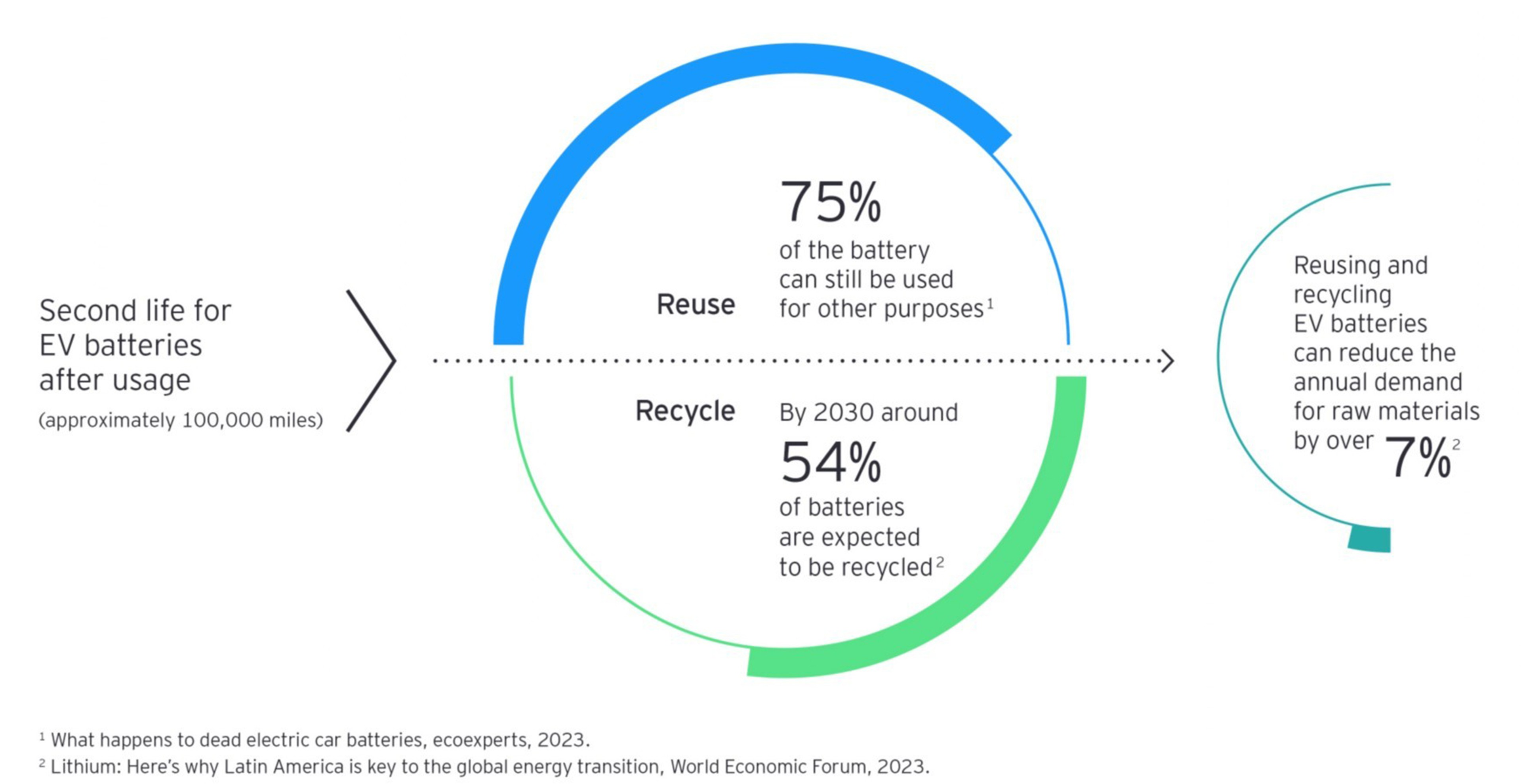
Chapter 1
Sustainability is about more than decarbonization
Automotive companies need to accelerate their progress against a much wider ESG agenda if they are to thrive in the years ahead.
The automotive industry has become more environmentally friendly in recent years. Between 2006 and 2021 emissions from car manufacturing in the European Union fell by more than 45%.1 And in the nine years up to 2021, the amounts of CO2 that new cars emit has been cut by around 22%.2 But there’s a long way to go in the decarbonization journey. The industry is still responsible for about 15% of total CO2 emissions in the EU.3
The difficulties facing automotive companies as they try to achieve net zero cannot be overstated, but carbon is only part of the ESG story. In the environmental space, for example, the auto industry is a major driver of biodiversity loss and desertification. Globally, for example, the industry uses about 30% of the leather hide produced in Brazil,4 which has been a primary cause of rainforest depletion in the Amazon. Companies do more to limit their impact on deforestation, and take positive steps by considering forests, wetlands and other crucial habitats when they think about the design and location of new buildings and production plants.
In the social space, several large auto companies have taken a proactive approach to addressing human rights abuses and promoting better pay and conditions in their supply chains. But how many can say they have a comprehensive strategy to address the social aspects of sustainability? What would be possible if you looked for ways to make a positive impact on all the societies and communities in which your business is active? Could you make pro-social activity a visible and tangible part of your business model?
Environmental and social issues are ultimately issues of governance. Whose needs is your organization really trying to meet, and how are those needs changing? Is it just about shareholders? More transparent reporting makes it easier to see and compare the impact companies have, but what would it mean to go beyond compliance and become a good or better corporate citizen? How might a broader understanding of the ways in which you create or destroy value lead to changes in the way your organization has traditionally behaved?
What we are talking about in each of these areas is taking sustainability beyond eliminating or mitigating the problems your company causes and asking instead how you can make a positive difference to the world. Seen through this lens, sustainability isn’t just one of several factors you consider sometimes, it is part of everything you do, every time, all the time. Many automotive leaders are having this kind of conversation already, but how far down the organization does it percolate?

Chapter 2
Become sustainable without sacrificing profitability
It doesn’t have to be a tradeoff between doing the right thing and making a profit.
There doesn’t have to be a tradeoff between doing the right thing and making a profit. Automotive companies can become sustainable while creating long-term value for all their stakeholders. In fact, the demand for greater sustainability is a generational opportunity to power future prosperity.
We’ve seen a fundamental shift over the last few years in the way people in the auto industry talk about sustainability. The industry’s performance has long been a function of how many vehicles are sold each year. But selling more vehicles at a higher price from a lower production cost has often conflicted with running a sustainable supply chain that supports the environment and local communities. From this perspective, if you try to be more sustainable, you hurt your profitability. It’s inevitable. Many NGOs believe that if we are to avoid climate catastrophe, we have to buy fewer cars and drive less.
But the equation is changing. One example is the rapid transition to electric vehicles. EVs sales are expected to surpass new car sales of other powertrains in Europe by 2027. Every major OEM has launched or scheduled EV models, and some are aiming to be completely electric in the next 10–15 years. Global sales of internal combustion engine (ICE) vehicles are predicted to be below 1% by 2040.5
However, the switch to electrification is only part of the answer. There isn’t enough lithium in the world to provide the number of batteries needed to power all these electric vehicles, and lithium mining is hardly a green business. In South America, it’s a major contributor to desertification. And is it really sustainable to scrap a five-year-old internal combustion engine car to buy a new electric vehicle? That question is not so easy to answer.
The transformation that will really change the sustainability equation is broader. It involves a move to business models based on the principles of the circular economy — reform, reduce, reuse and recycle. Today, for example, only 5% of lithium-ion batteries are recycled globally,6 whereas the World Economic Forum predicts that recycling could reduce the annual demand of raw materials by about 7% in 2030.7
The potential impact of a circular economy

This isn’t just about batteries. Many EVs are expected to reach their end-of-lifetime in the 2030s:8 how will we manage to deal with this surge?
What if we used circular economy principles to reimagine maintenance and service? When you get your oil changed, could you also get other parts of your vehicle replaced, recycled and reused, such as the glass in your windscreen or the leather in your seats? Several OEMs in Europe have already adopted a closed loop recycling process as part of a circularity strategy and are focused on expanding their remanufacturing business models.
It’s challenging to implement these principles all of the time, rather than some of the time, and to make fundamental business model changes in a context that is highly volatile. The key assumptions that underlie sustainability plans — such as fuel prices, government incentives, tax policies and consumer preferences — can change suddenly.
It’s important to identify and monitor relevant changes in the planning context and then analyze their potential impact on your business targets, plans and timelines at a detailed level. This will highlight any new problems, as well as opportunities, and enable you to course correct as necessary, but only where necessary, so you can adapt to a changing world with minimal loss of momentum.

Chapter 3
Own your future
Welcome the responsibility to transform and create a vision for your future.
The sustainability agenda can feel like something that’s being imposed on the organization from the outside, something executives can only react to. Change has to happen, but the mindset with which you engage is up to you. The companies that will thrive are those that welcome the responsibility to transform and lead from the front.
But leading doesn’t necessarily mean you always to be first, or that your organization has to become an environmental activist. The important thing is to find and walk a path that’s right for your business; to set goals and targets that are relevant and authentic to who you are and where you come from; and to then do the work that’s needed to achieve them. Transformation plans are more credible — not least to investors and your employees — when they are about doing the right thing and making money.
Philanthropy is important, but that isn’t what we are talking about. As we’ve argued, the suggestion that sustainability is good business might still require an imaginative leap for some. However, this is just one of many mindset-shifts that leadership requires.
It’s not possible to list the assumptions that people need to question and, if needed, let go of, because they will be different for each organization. Many automotive brands have a valuable heritage in luxury: sustainability and luxury might seem incompatible. Can they redefine what luxury means in a sustainable world, so they can build on their heritage and make it newly relevant? Many are trying. Can they do it in a way that stakeholders — including loudly critical voices — find credible, not just marketing or greenwashing?
Brands more focused on affordability might need to challenge some of their assumptions about the relationship between costs and sustainability in the supply chain. If you put your suppliers under intense pressure to keep costs down, will they make enough profit to invest in reducing their carbon footprint or in paying decent wages? How might you redefine affordability in a way that includes sustainability?
The automotive industry is changing fast. As leaders look to the future, it’s essential that they identify and challenge every assumption about what is probable and possible and how the organization they run today might create value tomorrow. They also need to consider what new assumptions related to sustainability need to be embedded in every decision. Where are the new opportunities and risks? What are the practical implications for what you are doing and how you are thinking now? By questioning key assumptions, you can identify new opportunities and build greater confidence in the resilience of existing strategy.

Chapter 4
Transform faster by making sustainability simple
Direct more focus on day-to-day actions that make sustainability normal and simple.
For automotive companies, sustainability goes to the heart of what they make, how they make it, and how they make money from it. Any kind of transformation will always create complex business and technical problems that need the best mix of insight, skills, attitudes and experience to solve. The difference with the transformation to sustainability is that nobody has done it before.
New technologies, buzzwords, problems, opportunities, targets and competing internal projects can make it feel like too much is happening at the same time. With too many parallel workstreams, companies can struggle to translate strategy into effective, daily implementation. They don’t have sufficient capacity and skills, and they lack processes and tools to measure progress.
If sustainability exists for too long as a parallel world within a company’s operating model, it will struggle to change effectively. We’ve seen automotive companies say they will use 100% renewable energy by 2030, only for their procurement department to agree on a deal to buy non-renewable energy for the next five years because it costs less and procurement processes have not been adjusted to align with sustainability goals. Sustainability must be incorporated stepwise into all areas of the operating model, processes and the organization. Indeed, at some point organizations will stop talking about sustainability, because sustainability will just be “normal” business.
This is a step-by-step process that can’t happen overnight. But as you achieve and report the positive impact you are making and how valuable this is, you will build internal support and commitment and attract more investment. Decide that sustainability in all its forms matters, commit to doing something meaningful about it, look for ways to create value, take the action required, and stay on course. You’ll be helping to build automotive industry and securing the continued success of your business.
Related articles
Summary
Decarbonization represents just one aspect of the transformation needed to make the automotive industry sustainable. To succeed in the future, companies must embrace a comprehensive ESG agenda, encompassing an ever-growing range of environmental and social issues. It’s possible to become more sustainable without sacrificing profitability, to take control of your future, and to transform faster by making complex sustainability challenges simpler.


